Tree fruit: Fresh insights to combat pests and disease
16th April 2024
This year’s NIAB Tree Fruit Day saw a range of scientists sharing alternative products and management strategies for tree fruit pests and diseases, as loss of chemistry becomes an increasing challenge. Deputy editor Sarah Kidby reports.
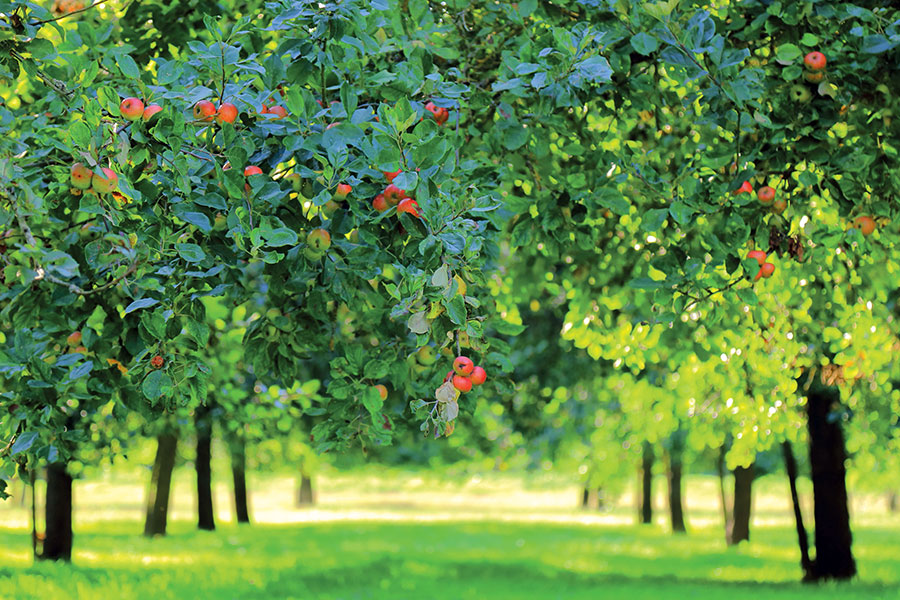
Apple canker
With very limited chemistry available, controlling the sources of apple canker infection is key, explained NIAB’s Mat Papp-Rupar. Mature cankers are a “big no-no” – they must be cut out as soon as possible, as once they mature, they produce ascospores which spread long distances. Other sources of infection may be fruit on the orchard floor, wind breaks and pruning material. Infections occur through tree wounds such as pruning wounds, petal scars or growth cracks, for example. Cankers should be removed before and during picking – this is the most important time – then, if possible, after harvest, a mid-winter tidy up and a spring clean to prevent spring infections. If this is done every year, within five years canker will be reduced to practically zero, Mat said. Wounds such as leaf scars can be covered with Captan/tebuconazole, which will reduce the infection rate a little.
Three trials explored potential new treatments for canker, including biocontrol systems, new fungicides not yet registered for apples/canker, plant oils and plant extracts. Two of the new fungicides were found to be effective, biostimulants showed some promise with a little decrease in canker versus the control, whereas biocontrols were largely ineffective – though more research is needed and some success was seen in one trial with Trichoderma on rasp wounds. The real winner, however, was building grade hydrated lime, which was applied at 50kg/ha dissolved in 300 litres of water – but keeping inoculum levels low was key, Mat said.
As no tested product will completely replace the current standard fungicide programme, new methods will need to be combined alongside other management methods such as nutrition – high nitrogen levels in the soil or the tree will worsen canker. Additionally, research has shown potassium could be a factor as most of the orchards with low canker levels had potassium in the soil below 124ppm, so further research into this is needed, Mat added. Other stressors such as drought or water logging may also affect susceptibility.
Tackling brown rot in cherries
Brown rot can cause fruit losses of 50–75% in orchards, plus additional losses of 25–50% in transit and storage. Chemical sprays are available, as are biocontrols to help prevent resistance build-up, which is already an issue. Physical control measures include removal and disposal of inoculum, which is key, and removing latently infected fruit at picking to avoid losing batches of fruit in storage, Mat continued.
A recent post-harvest fruit dipping trial explored the effects of fungicides, biocontrols and sterilants in guarding against all types of rot in commercially collected Sweetheart cherries. Fruit was dipped for 30 seconds in different suspensions at the recommended rate one day after inoculation, then stored for 18 days in 1–2ºC and 99% humidity, then eight days of shelf-life storage in a ‘worst-case scenario’.
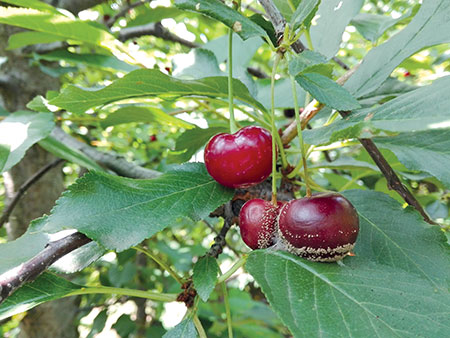
The results showed that for cold-stored healthy fruit, there was very little rot (2–5% of fruit), but most of the products trialled offered slight improvements over the control. After the additional eight days of shelf-life storage, 50% of the fruit in untreated controls was rot-free. Over 75% of fruit treated with fungicides three and four had no rot, while other treatments varied in their effects, but all were better than the control apart from the sterilant. Biocontrols had moderate efficacy against brown rot, and in some cases, very good efficacy against botrytis, but otherwise were effective to a lesser extent. Previous research also found a 30–60% reduction in brown rot when biocontrols (Bacillus subtilis and Aureobasidium pullulans) were applied two weeks before picking. Whilst this is still in the pipeline to get to market, it could be useful in a couple of years, Mat noted.
As efficacy varied widely between treatments, it’s important to know which rots are high risk in your orchard when choosing one of these alternative products, Mat said. Putting clean fruit into good storage was also key. Additionally, the fungicide treatments used did not exceed the MRLs, so they have been recommended to the EAMU for post-harvest cherry protection.
Finally, Mat shared plans to create a proof-of-concept tool for non-destructive detection of brown rot. This would use optical coherence tomography to scan fruit and identify that which has a latent brown rot infection. It’s hoped that in a couple of years there could be a portable scanner that plugs into the conveyor, and notifies growers of high-risk fruit, which could work well alongside biocontrols.
Apple scab
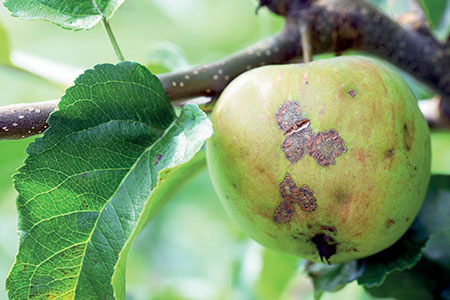
With apple scab being one of the industry’s major challenges, NIAB’s Tom Passey shared findings from a trial of several products that were either authorised, or highly likely to be authorised, in the UK. Products were applied to potted trees a day prior to, or a day after, infection. After 2–3 weeks it was determined that AHDB 9711 worked as a preventative and a treatment, elicitor HCP 9692 worked as a preventative and AHDB 9808 worked as a treatment. Two bacterial bio-control agents did not work during the trial, however more research is needed as little is known about these products. The products with some efficacy will now be trialled in an orchard setting.
PhD student Katie Stewart, meanwhile, explored more effective ways to remove fallen leaf litter – the main source of primary inoculum – in autumn/winter for the next growing season. Shredding and burning is the traditional method but shredding may not remove all the inoculum, and burning has negative environmental implications. Applying a microbial agent (Trichoderma spp) post-harvest significantly reduced leaf litter compared to an untreated control, which was raised off the ground. The experiment was repeated and results were still pending at the time of writing.
Wildflower impacts
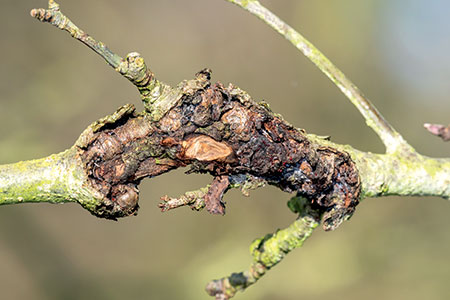
Research led by the University of Reading, presented by Celine Silva of NIAB, found only 48% of trees with flower margins established nearby had fruit damage, compared to 80% in orchards without flowers. Findings suggest farmers could harvest up to an additional 2,420kg/ha (6.9%) of undamaged, premium apples by installing flower margins on orchards.
As part of the study, large, mature wildflower margins, more than 5m wide, were planted. They included grasses and flowers chosen to supply year-round food sources for diverse communities of predatory insects. The flower margins not only reduced the spread of aphids on trees, but also lowered the number of fruits attacked on infested trees. Apples near flower borders had over a third less chance of fruit damage, even during peak aphid outbreaks. Significant reductions in damaged crop extended up to 50m into orchards from the floral habitat.
Woodlice – a new threat to apples
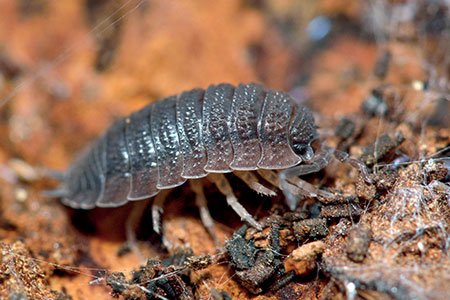
In recent years, some growers, particularly in Kent, have seen large numbers of woodlice in orchards and damage to fruit, said Jude Bennison, ADAS. Recent research found large numbers of woodlice and damaged fruit were more likely on apple clusters than single fruits. Russeting around the stalk/roughened skin also seemed to allow woodlice damage. Additionally, damage was reported to be worse later in the season on late picked varieties, such as Gala and Braeburn.
When it comes to control measures, AHDB research has previously highlighted success using ferric phosphate slug pellets sprinkled onto the growing media in tomatoes. Work in Germany also found entomopathogenic nematodes formulated together with a bait could be effective against woodlice – though neither of these methods have yet been trialled in orchards. Jude suggested using these methods in combination with attractants and repellents, or providing woodlice refuges to deter them from apple trees.
Could earwigs tackle woolly apple aphid?
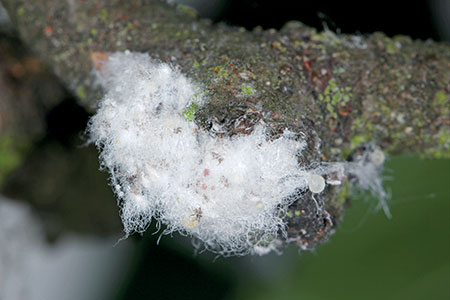
A field study in June 2023 explored the mass relocation of earwigs into three orchards with a woolly apple aphid problem, using Wignests. Available from Agrovista and Russell IPM, Wignests are a wooden shelter trap containing food that can be hung on trees, bringing earwigs up into the canopy of the trees that are most challenged by aphids.
One of the researchers, Sarah Arnold, said the results are “cautiously positive” with treated plots overall having lower numbers of aphids in the bark, and quite low numbers on some of the young shoots. A study from Catalonia resulted in good aphid control when earwigs were released in orchards every year for five years. Earwig control is also compatible with the parasitoid A. mali. Similar US studies have also found a trend towards lower pest density, but this wasn’t a strong effect, while Bischoff et al bagged tree branches and added earwigs, finding aphid control was better on less complex branches (shorter with fewer side shoots) so this could also be a factor.
New control techniques for apple sawfly
Sawfly is a re-emerging pest due to lack of chemical controls, and can cause crop losses of up to 80%. There is no conventional insecticide so control relies on fruit thinning and picking out affected apples. Spending 11 months underground, there is a very limited control window for this pest.
NIAB’s Francesca Elliot shared heat maps that show adult sawfly numbers peaked in early May and declined in late May to June across all sites tested. She therefore recommends deploying traps in early spring and using orchard-specific monitoring strategies to optimise trap placement and density. Traps should be removed following petal fall to avoid trapping beneficial insects. And as the number of adults is not homogenous across sites, traps should be targeted to hotspots.
SWD: Sterile insect control
Promising results were shared from a 2023 study using sterile insects to control spotted wing drosophila (SWD) on 11ha of raspberries, which included blocks of early, mid and late varieties. The strategy involves releasing sterile males to mate with wild females to prevent offspring. Glen Slade, of BigSis, said over five weeks, red sticky traps revealed an 88% suppression of adult insects compared to the control. Despite 139% more females in the early block, flotation tests revealed a 62% lower count of larvae per fruit. The two later periods showed up to 80% reduction – and fruit waste also fell as a result.
Forest bug – an emerging pest
Forest bugs cause deep pitting in apples and pears, resulting in huge losses as fruit is unmarketable. Research shared by NIAB’s Francis Wamonje found pheromones are unlikely to be involved in forest bug aggregation, but early results suggest blue light traps could be a promising deterrent.
Codling moth control
Charles Whitfield, NIAB, said codling moth will become an increasingly difficult pest to control due to climate change and loss of insecticides, but a review of 350 global papers highlights a number of promising developments. This includes automated traps and AI, biological control and netting. Control is most effective when applied on an area wide basis – over a number of seasons to bring the population down to a manageable level, he said.
Mating disruption (MD) could also prove successful if combined with the use of female attractants. It has been previously underused as it can go wrong, especially if done area-wide with a neighbouring farm or nearby residential area with fruit trees. However, research in the US saw a significant reduction in fruit damage when MD was deployed (not area wide) combined with large numbers of female attractants in traps 60/ha.
Read more fruit news
